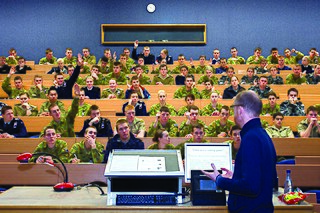
A community college is a type of educational institution. The term can have different meanings in different countries: many community colleges have an "open enrollment" for students who have graduated from high school. The term usually refers to a higher educational institution that provides workforce education and college transfer academic programs. Some institutions maintain athletic teams and dormitories similar to their university counterparts.

Service-learning is an educational approach that combines learning objectives with community service in order to provide a pragmatic, progressive learning experience while meeting societal needs.

A lecture is an oral presentation intended to present information or teach people about a particular subject, for example by a university or college teacher. Lectures are used to convey critical information, history, background, theories, and equations. A politician's speech, a minister's sermon, or even a business person’s sales presentation may be similar in form to a lecture. Usually the lecturer will stand at the front of the room and recite information relevant to the lecture's content.

Student affairs, student support, or student services is the department or division of services and support for student success at institutions of higher education to enhance student growth and development in the United States and abroad. People who work in this field are known as student affairs practitioners or student affairs professionals. These student affairs practitioners work to provide services and support for students and drive student learning outside of the classroom at institutions of higher education.
Residence Life is the terminology used to describe the comprehensive program that surrounds the experience of living "on and off campus" in a residence hall at a college or university in Canada and the United States. Residence Life is usually structured with planned events, a code of conduct and/or ethics, and a relatively large array of staff.
A learning community is a group of people who share common academic goals and attitudes and meet semi-regularly to collaborate on classwork. Such communities have become the template for a cohort-based, interdisciplinary approach to higher education. This may be based on an advanced kind of educational or 'pedagogical' design.
The National Survey of Student Engagement (NSSE) is a survey mechanism used to measure the level of student participation at universities and colleges in Canada and the United States as it relates to learning and engagement. The results of the survey help administrators and professors to assess their students' student engagement. The survey targets first-year and senior students on campuses. NSSE developed ten student Engagement Indicators (EIs) that are categorized in four general themes: academic challenge, learning with peers, experiences with faculty, and campus environment. Since 2000, there have been over 1,600 colleges and universities that have opted to participate in the survey. Additionally, approximately 5 million students within those institutions have completed the engagement survey. Overall, NSSE assesses effective teaching practices and student engagement in educationally purposeful activities. The survey is administered and assessed by Indiana University School of Education Center for Postsecondary Research.
Student Development Theory refers to a body of scholarship that seeks to understand and explain the developmental processes of how students learn, grow, and develop in post-secondary education. Student development theory has been defined as a “collection of theories related to college students that explain how they grow and develop holistically, with increased complexity, while enrolled in a postsecondary educational environment”.
Peer mentoring is a form of mentorship that usually takes place between a person who has lived through a specific experience and a person who is new to that experience. An example would be an experienced student being a peer mentor to a new student, the peer mentee, in a particular subject, or in a new school. Peer mentors are also used for health and lifestyle changes. For example, clients, or patients, with support from peers, may have one-on-one sessions that meet regularly to help them recover or rehabilitate. Peer mentoring provides individuals who have suffered from a specific life experience the chance to learn from those who have recovered, or rehabilitated, following such an experience. Peer mentors provide education, recreation and support opportunities to individuals. The peer mentor may challenge the mentee with new ideas, and encourage the mentee to move beyond the things that are most comfortable. Most peer mentors are picked for their sensibility, confidence, social skills and reliability.
Alexander Astin is the Allan M. Cartter Distinguished Professor Emeritus of Higher Education and Organizational Change, at the University of California, Los Angeles.
Kathryn Patricia Cross is a scholar of educational research. Throughout her career, she has explored adult education and higher learning, discussing methodology and pedagogy in terms of remediation and advancement in the university system.
University student retention, sometimes referred to as persistence, is of increasing importance to college administrators as they try to improve graduation rates and decrease a loss of tuition revenue from students that either drop out or transfer to another school. The topic is also of high importance to students, who invest their time and resources in support of the hope of earning a degree.
Academic advising is, according to the National Academic Advising Association, "a series of intentional interactions with a curriculum, a pedagogy, and a set of student learning outcomes. Academic advising synthesizes and contextualizes students' educational experiences within the frameworks of their aspirations, abilities and lives to extend learning beyond campus boundaries and timeframes."
Strategic Enrollment Management [SEM] is a crucial element of planning for new growth at a university or college as it concerns both academic program growth and facilities needs. Emerging as a response to fluctuations in student markets and increasing pressure on recruitment strategies in higher education, SEM focuses on achieving student success throughout their entire life cycle with an institution while increasing enrollment numbers and stabilizing institutional revenues. SEM strategies accomplish the fulfillment of an institution's mission and student experience goals by strategically planning enrollments through recruiting, retaining and graduating specific cohorts of students followed by targeted practices to build a lifelong affinity with the institution among alums. In addition to a focus on student achievement, SEM also fundamentally understands the student as holding the role of a learner in addition to a customer and citizen of the global community.
An open-door academic policy, or open-door policy, is a policy if a university accepting to enroll students without asking for evidence of previous education, experience, or references. Usually, payment of the academic fees is all that is required to enroll.
Online tutoring is the process of tutoring in an online, virtual, or networked, environment, in which teachers and learners participate from separate physical locations. Aside from space, literature also states that participants can be separated by time.

Reynol ("Rey") Junco is an American psychologist and education and social media researcher. He is known for his pioneering work on using social technologies in higher education. He is a fellow at the Berkman Klein Center for Internet & Society at Harvard University.
Helen "Lena" S. Astin was a Greek-born American academic who was a professor at the University of California, Los Angeles and Senior Scholar of the Higher Education Research Institute at UCLA. She is most known for her scholarly activism and research concerning higher education issues of women and minority students, as well as women’s career development. She is a recipient of the Distinguished Research Award of Division J of the American Education Research Association and received the Howard Bowen Distinguished Career Award from the Association for the Study of Higher Education.
Online learning involves courses offered by postsecondary institutions that are 100% virtual, excluding massively open online courses (MOOCs). Online learning, or virtual classes offered over the internet, is contrasted with traditional courses taken in a brick-and-mortar school building. It is the newest development in distance education that began in the mid-1990s with the spread of the internet and the World Wide Web. Learner experience is typically asynchronous, but may also incorporate synchronous elements. The vast majority of institutions utilize a Learning Management System for the administration of online courses. As theories of distance education evolve, digital technologies to support learning and pedagogy continue to transform as well.
Sex differences in education in the United States refers to the specific issues, such as gender-based discrimination related to coursework and use of disciplinary action, that American students of all genders encounter. Furthermore, while sex differences in education explains the prevalence of gender-based differences in education on a global scale, the American education system includes specific forms of gender discrimination dissimilar to other countries.




